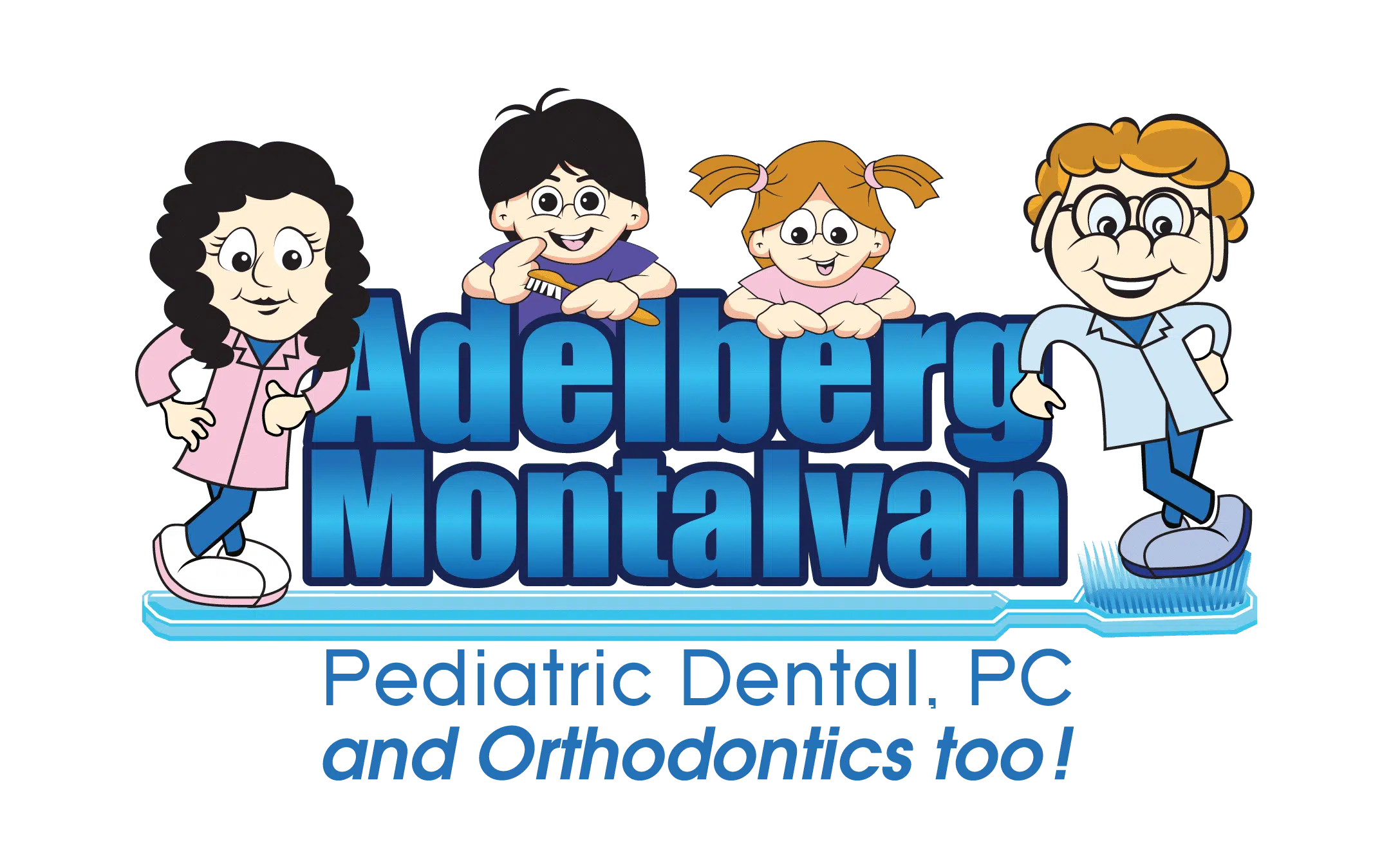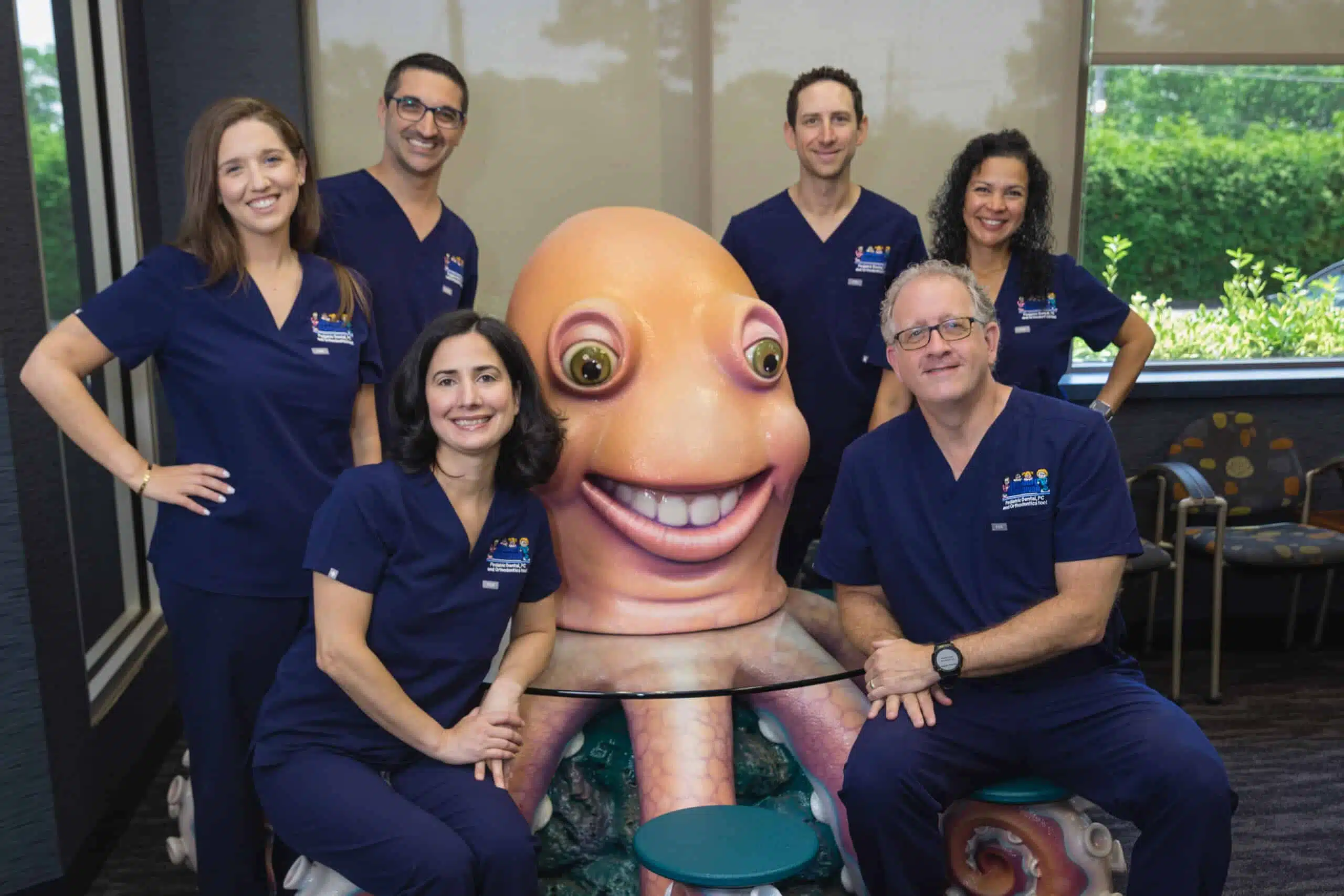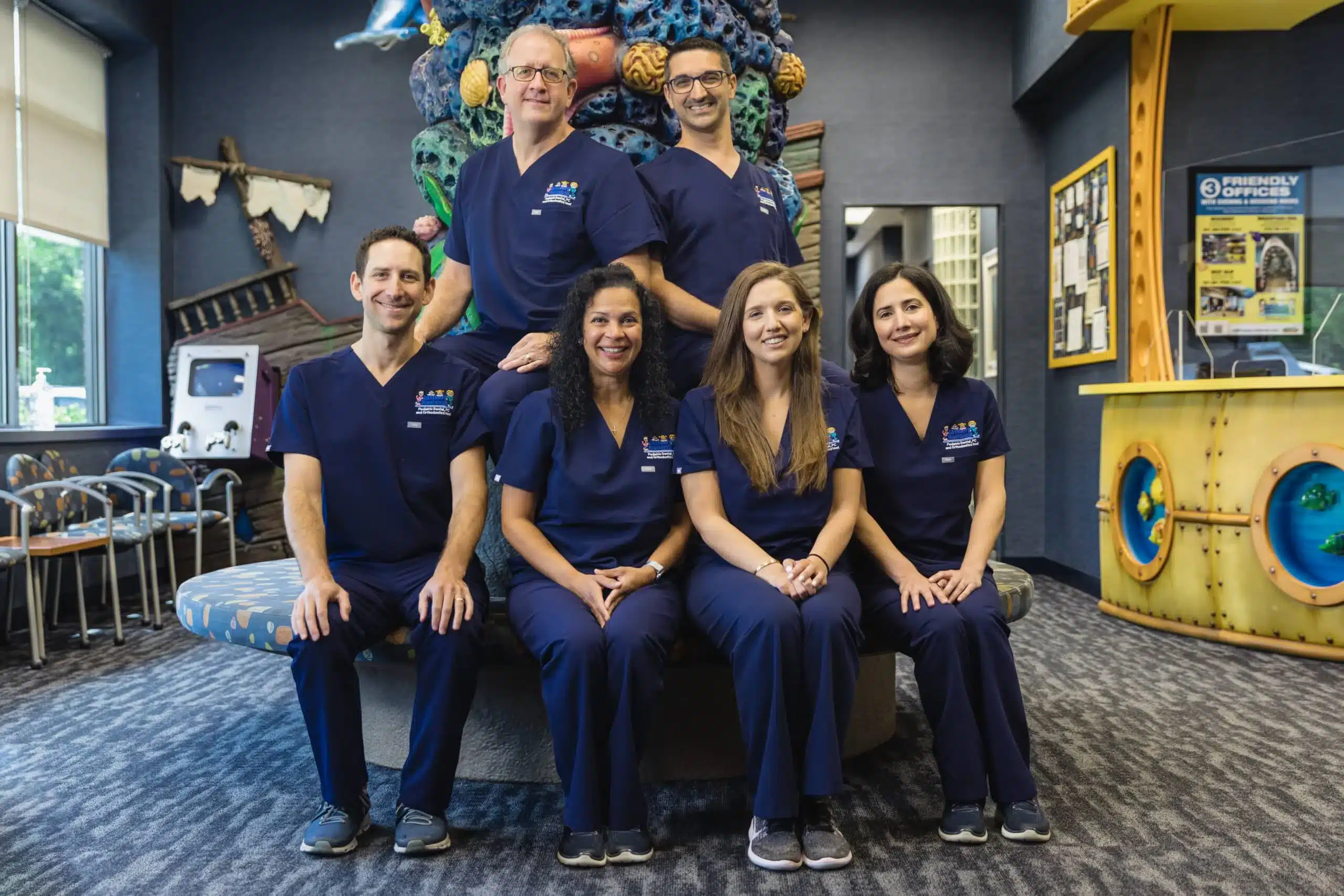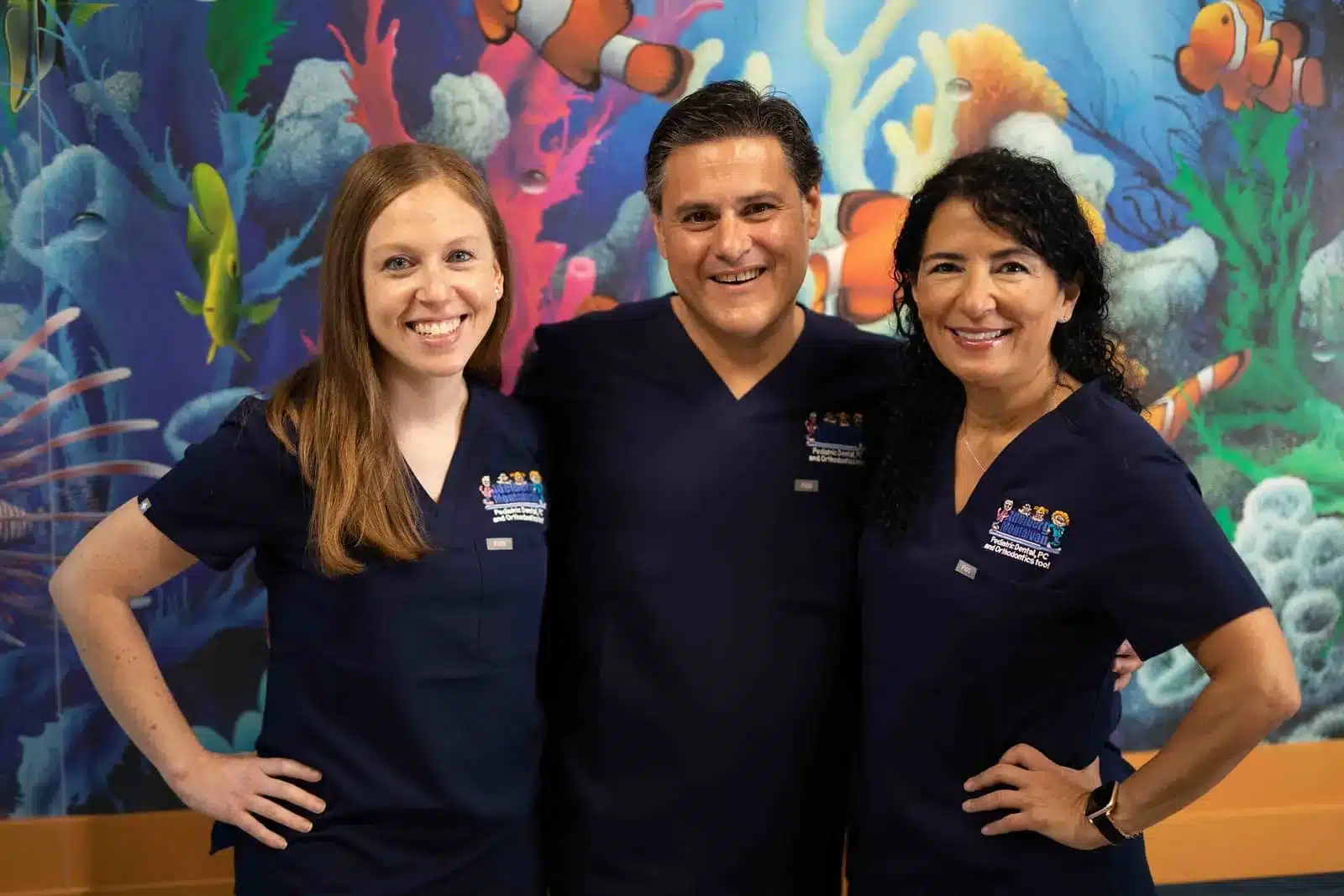All of our pediatric dentists and orthodontists are board-certified and have completed 2 to 4 years of extra training. All offices have a fun environment creating a great experience for your child! Our goal is a positive experience that will affect your child’s life forever.
Our office focuses on being a fun and easy environment for all of our families. We have an excellent team to help you and provide a clean, fun office. We help with insurance claims and explain your benefits. Our reception areas are fun and themed and have video games, TVs, and free beverages.
Pediatric Dentistry
The American Academy of Pediatric Dentistry recommends that a child has their first dental exam by age 1 or 6 months after the eruption of their first tooth. This allows for the establishment of a dental home and provides parental education in the prevention of early childhood caries.
The average age to lose the first baby tooth is 6 to 7 years old, with some earlier or later exceptions depending on their specific teething pattern. It is important that the sequence is correct so come in and visit to check it out.
Tooth brushing should start with the eruption of the first tooth. Brushing should be done after breakfast and before bedtime with the use of a non-fluoridated toothpaste until they are able to spit.
Laser Dentistry
Laser dentistry uses a laser to clean out most cavities without the need for shots. It also allows for the treatment of multiple teeth in multiple areas of the mouth and can speed up the number of visits needed. There is no vibration and a more pleasant sound. Because you are not numb, children and adults can go back to activities right away without feeling numb or risking biting their lips.
Lasers in dentistry have been used for about 25 years. The laser is what cuts the diseased tooth or soft tissue. The laser uses light energy to vaporize the area and provide a clean healthy tooth structure for the dentist to restore. When cutting soft tissue, a huge benefit with using a laser is that it also cauterizes the area. Most people see the laser as a better and more gentle way of doing dental work.
Experience. Our team has the most training and hands-on experience of any dental office in the area. We have 8 lasers across our locations.
Insurance & Payment Plans
We participate with many insurance plans and work with almost ANY plan. Most of our patients use insurance for all or part of the treatments. Even many out-of-network plans cover 100% of preventive treatment and often a very high percentage of work that may need to be done. Call our office and we can call your insurance for you to explain and verify benefits.
We collect payment as treatment occurs but many insurance plans make the cost very reasonable. We offer in-house financing on a case-by-case basis. Orthodontic treatment is always on an interest-free payment plan. Our goal is to treat your children and family well. Please speak with our team if you need any of these options; you may even be surprised by how good your dental plan is.
Restorative Dentistry
Aside from eating and aesthetics, one of the most important jobs for the baby teeth is to hold a healthy space for the future adult teeth to take their place. If baby teeth that are decayed or infected aren’t treated properly, it can cause infection and abscesses which can cause the child pain and discomfort or even loss of the tooth or more serious problems.
When baby teeth are lost too early, they require a space maintainer appliance to hold the space open for the adult tooth. If space isn’t maintained, you can lose the space causing the adult teeth to become stuck and unable to come in.
It is a silver crown that can be used to repair a badly decayed baby molar (back tooth) and prevent it from decaying further. They are made to fit the exact size and shape of a child’s molar and can be an excellent option in certain circumstances. Unlike adult crowns, they are completed in just a single quick visit.
No problem at all! The tooth that had a silver crown will fall out and can go to the tooth fairy so the adult tooth can come in. Some tooth fairies give extra for the crowned tooth.
Yes! white is an option but it is not for everyone. Discuss with your doctor what is best for your child. Please be assured that we do not use mercury amalgam. The “silver” is medical-grade stainless steel. All of our other restorations are white composite.
All of our dentists and team are specially trained to work with children. Our dental lasers mean that most treatment is done with no shots or needles. Additionally, we use state-of-the-art techniques and only white fillings. We have more laser experience than any dentist in the area.
Dental Trauma
If this occurs, call our office as soon as possible to see one of our board-certified pediatric dentists as early as possible. DO NOT try to put the tooth back in because you can damage the surrounding tissues and the adult tooth.
You can call the office to make an emergency visit. If you have a tooth fragment, you should bring it with you to the dentist. We will take an x-ray of the traumatized tooth and establish if treatment is necessary. Often we can “bond” the tooth and within one visit your child can look as if nothing happened.
Our office is multi-location and open many hours. Also, we are on call after hours. You speak to a doctor directly, not a service. Additionally, we are best trained and equipped as specialists to handle pediatric emergencies or refer to another provider as needed.
Preventive Dentistry
Xylitol is a sugar alcohol that can be used as a sweetener. It reduces the risk of cavities by not allowing the bacteria to adhere to the tooth’s surface. It also maintains a healthy neutral pH in your mouth. It can be an excellent alternative to fluoride.
We recommend not using fluoride toothpaste for any young children who do not spit out their toothpaste. When your child spits out their toothpaste consistently, fluoride is a great way to keep cavity risk low.
Fluoride that is ingested (through a vitamin) will help the adult teeth that aren’t in the mouth yet grow stronger and more resistant to cavities. Fluoride that is applied topically (toothpaste, fluoride treatments, fluoride varnishes) is used to strengthen the teeth that are currently in your child’s mouth. Children should be on fluoride vitamin supplements until your dental professional advises otherwise.
Sealants
Sealants are strong protective resin coatings that fill in the pits and grooves on the biting surface of the teeth. They help to prevent food, bacteria, and plaque from entering these grooves and causing decay.
Sealants are typically applied to back adult teeth, the six and twelve molars, so usually around the age of 7 and other teeth around age 12. Baby teeth can also be sealed if desired, if high risk, or if extensive cavities are present on other teeth.
Yes and no! Often after a restoration, no sealant can be placed, but if any sealable part of the tooth is healthy the remaining portion is sealed by our office. Many times, if caught soon enough, the cavity is small and we can seal the rest of the tooth.
Usually many many years and some adult patients still have sealants that were placed when they were a child. We check the sealants at every visit and repair or redo them as needed. As with anything, the sealants will last longer if you take proper care of your teeth. Sealants are the best protection available against cavities but they are not infallible. Even a sealed tooth can get a cavity.
As pediatric specialists, we have placed many more sealants than adult dentists and we use the best material available (and it is BPA-free).
Special Needs
You should schedule your child’s dental visit the same as you would any other child. A child with special needs would benefit from extra dental check-ups because depending on their level of functioning, they may not be able to communicate if there are any dental-related issues. It is always better to get them used to the dental chair and for your dental professional to ensure that everything is healthy.
We follow the guidelines set by the American Academy of Pediatric Dentistry so that we can provide the best treatment possible for your child. Coming two times a year makes it easiest to spot problems early and teach good habits to prevent dental problems.
If we recommend sedating your child for dental care, we feel that it is the safest and most effective way to treat their needs. Some children require sedation due to special needs, behavioral issues, or a large amount of treatment needed at a very young age. We want to make their experience the best it can be to avoid any dental-related trauma in the future. This will ensure they will continue to maintain their oral health in their future years.
As specialists in children’s care, our team is best able to understand the unique needs of children with special medical or emotional needs. When needed, we use a medical MD anesthesiologist in our own office. We can provide a higher level of care that is better for the child and easier for the family.
Orthodontics
Our board-certified orthodontists work closely with your child’s pediatric dentists (a benefit of being in the same building!) allowing us to coordinate the best possible dental care for your child.
Invisalign is a series of clear plastic aligners used to straighten teeth. The advantages of Invisalign include esthetics, ease of brushing and flossing, few dietary restrictions, and few emergency appointments. However, not everyone is a candidate for Invisalign. Our orthodontists will determine whether or not you or your child is a candidate and review all the options for treatment.
Invisalign is a great option for any child/teen/adult that is a candidate for it. It allows the patient to clean their teeth like they didn’t have braces because the aligners are removed when eating and cleaning the teeth. Also, it is more aesthetically pleasing than traditional metal braces.
Some children require 2 phases of treatment. For example, if a child has hardly any space, the orthodontist can try to provide more space with the first phase of treatment to avoid any of the adult teeth getting stuck or even to avoid having to have the next full phase of treatment later. Also, some children have missing or extra teeth that may require earlier intervention from an orthodontist. Some appliances that the orthodontist recommends can only be done when the child’s bones are still developing and are soft enough to manipulate. Sometimes, starting too late can limit what the orthodontist is able to do with certain appliances.
At the initial consultation visit, the orthodontist will examine your child, take any necessary photographs and x-rays and come up with a treatment plan tailored specifically for your child.
The average treatment time for most cases is about 1-2 years. Factors that impact treatment time include: the age of the patient, the complexity of the bite, as well as compliance with appointments and proper home care.
We get this question a lot! Yes, our orthodontists all have a great deal of experience treating parents too! As a matter of fact, moms/dads and their children love going through the experience of orthodontic treatment together!
Frenectomy
There are 2 types of frenectomies. Maxillary frenectomies help to release a lip tie by removing the thick tissue connecting the upper gums to the front teeth. Lingual frenectomies release a tongue tie by removing the tissue connecting the tongue to the floor of the mouth. This can allow better speech, feeding, growth, and development, and can aid in orthodontics.
Babies could benefit from frenectomies to help with any breastfeeding or bottle-feeding restrictions. Sometimes freeing the lip and tongue allow the baby to latch properly.
The laser is able to cut through soft tissue with decreased healing time and bleeding and also little to no scar tissue.
Most patients do well with light local anesthetic and sometimes sedation. Patients are always surprised by how easy it is with our advanced laser technology.
Many babies that can not breastfeed well or have problems being fussy, gassy, or falling asleep feeding can be helped with a lip or tongue tie release. It is best to consult with a lactation consultant to be evaluated. If a frenectomy is needed we can help with our laser.
At our office, all of our doctors are specially trained and we have been using lasers for this procedure for many years. Lasers offer a much better and easier frenectomy.
Mouthguards
A mouthguard is any type of device that protects the mouth from traumatic injury. There are many types and a custom mouthguard is a recommended minimum investment in safety.
The custom mouthguard starts at $80 and is made from the mold of your child’s teeth. A custom mouthguard is the best option for your child’s safety and is an important part of the equipment necessary for contact sports. It will protect your child against head and neck injury by cushioning falls and avoiding concussions or other injuries to the jaw. Having a custom one that fits properly will encourage the use and will stay in place when the player gets hit.
Yes! A custom mouthguard can be made for a child in orthodontic treatment. Unlike an over-the-counter boil and bite mouthguard, in a custom mouthguard, we are able to create a track allowing for tooth movement. The orthodontic treatment adds devices to the mouth that could easily do damage in a traumatic event. For this reason, it is highly recommended to get a custom mouthguard.
An impression or mold of your child’s teeth is taken, your child chooses a color, and then you return in 2 weeks or less for your child to try on your custom-made mouthguard and have adjustments made if needed. Bring it in with you when you visit our office so we can make sure it stays in the best shape possible!
We have experience and as dental professionals can make a superior product compared to retail or over-the-counter mouthguards. Many of our doctors have taken additional courses and are certified in sports dentistry.
Diet & Nutrition
Unfortunately, even with watering down juice or soda, sipping on those types of drinks throughout the day will cause an increased risk for cavities because the teeth are bathing in sugar all day long.
If you are nursing throughout the night or before bedtime without brushing your child’s teeth, it will increase the risk of developing cavities at a younger age. Even if nursing in the middle of the night, the teeth should be wiped with tooth wipes or brushed with non-fluoride toothpaste after nursing.




